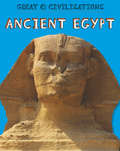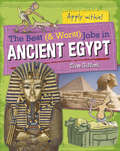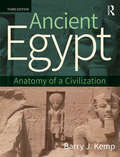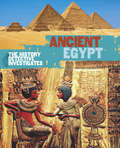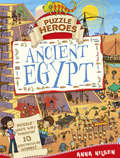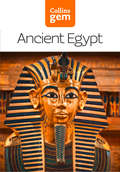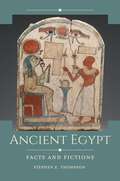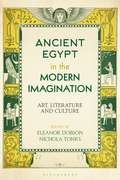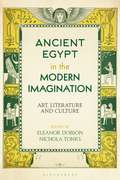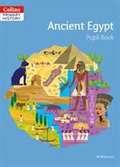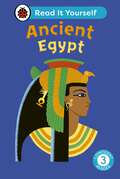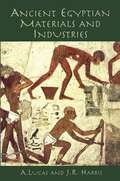- Table View
- List View
Ancient Egypt: (pdf) (Dkfindout! Ser.)
by Dorling Kindersley Publishing StaffWhat will you learn about Ancient Egypt today? Travel back in time to learn all about the pharaohs of Egypt, decode Egyptian hieroglyphs, and see how the Great Pyramid of Giza was built. See if you can survive the game of childhood, take a tour of an Egyptian home, and find out how a mummy was made. Packed with fun facts, amazing pictures, and quizzes, this book really will have children coming back for more!
Ancient Egypt: Ancient Egypt (Great Civilisations #2)
by Anita GaneriEach book in Great Civilisations approaches its subject through a scene-setting spread Who/where were the... then introduces the achievements of the chosen civilisation through 12 structures or objects, each of which illustrates a key aspect or theme. Writing, architecture, industry, warfare, transport and learning are all covered in the same simple, colourful and engaging way. Fact boxes and panels present incidental information and point the reader to the importance of parallel developments in other parts of the world. Ancient Egypt looks at one of the best-known ancient civilisations. Through objects as complex and magnificent as Tutankhamun's funeral mask and sarcophagus or as simple as a shaduf, readers gain a picture of who was whom in ancient Egypt and how the civilisation in which they lived really worked.
Ancient Egypt: Ancient Egypt (The Best and Worst Jobs #14)
by Clive GiffordWhat sort of work could job-hunters in Ancient Egypt expect to find? What might their colleagues be like? Ancient Egyptians might become law officers, using sniffer dogs to track down criminals, or professional mourners, paid to throw dust over themselves at funerals. What were the pay and conditions like for a farmer or a scribe in Ancient Egypt? Which were the most dangerous jobs and which the most high status? Throughout the book, job adverts give an idea of the qualities and skills needed for each role and there's a verdict at the end to evaluate whether it was one of the best or worst jobs available. Photographs of artefacts from the period are married with humorous artwork to bring the workers of the era to life.
Ancient Egypt: History In An Hour (The\history In An Hour Ser.)
by Anthony HolmesLove history? Know your stuff with History in an Hour.
Ancient Egypt: An Introduction (PDF)
by Salima IkramThis book provides an introduction to one of the greatest civilizations of all time - ancient Egypt. Beginning with a geographical overview that explains the development of Egyptian belief systems as well as its subsequent political development, it examines methodology, the history of the discipline of Egyptology, religion, social organization, urban and rural life, and death. It also includes a section on how people of all ranks lived. Lavishly illustrated, with many unusual photographs of rarely seen sites that are seldom illustrated, this volume is suitable for use in introductory-level courses on ancient Egypt. It offers a variety of student-friendly features, including a glossary, a bibliography, and a list of sources for those who wish to further their interest in ancient Egypt.
Ancient Egypt: Anatomy of a Civilization
by Barry J. KempThis fully revised and updated third edition of the bestselling Ancient Egypt seeks to identify what gave ancient Egypt its distinctive and enduring characteristics, ranging across material culture, the mindset of its people, and social and economic factors. In this volume, Barry J. Kemp identifies the ideas by which the Egyptians organized their experience of the world and explains how they maintained a uniform style in their art and architecture across three thousand years, whilst accommodating substantial changes in outlook. The underlying aim is to relate ancient Egypt to the broader mainstream of our understanding of how all human societies function. Source material is taken from ancient written documents, while the book also highlights the contribution that archaeology makes to our understanding of Egyptian culture and society. It uses numerous case studies, illustrating them with artwork expressly prepared from specialist sources. Broad ranging yet impressively detailed, the book is an indispensable text for all students of ancient Egypt and for the general reader.
Ancient Egypt: Anatomy of a Civilization (All That Matters Ser.)
by Barry J. KempThis fully revised and updated third edition of the bestselling Ancient Egypt seeks to identify what gave ancient Egypt its distinctive and enduring characteristics, ranging across material culture, the mindset of its people, and social and economic factors. In this volume, Barry J. Kemp identifies the ideas by which the Egyptians organized their experience of the world and explains how they maintained a uniform style in their art and architecture across three thousand years, whilst accommodating substantial changes in outlook. The underlying aim is to relate ancient Egypt to the broader mainstream of our understanding of how all human societies function. Source material is taken from ancient written documents, while the book also highlights the contribution that archaeology makes to our understanding of Egyptian culture and society. It uses numerous case studies, illustrating them with artwork expressly prepared from specialist sources. Broad ranging yet impressively detailed, the book is an indispensable text for all students of ancient Egypt and for the general reader.
Ancient Egypt: All That Matters Ebook Epub (All That Matters)
by Barry J KempFor three thousand years a dominant force, Ancient Egypt is arguably the most successful and longest lasting human civilization yet. In this pacy guide, world renowned Egyptologist Professor Barry Kemp seeks to explain why Ancient Egypt was able to thrive with such stability for such a long time. The answers may be surprising - Kemp shows that human rights and career progression played an important role, as well as the traditional forces of slave labour and religion. Taking a thematic approach, Kemp examines ancient Egypt's georgraphy, rulers, society, morality, family life, art and architecture, military, science, philosophy and religion. He then goes on to ask what happened to Ancient Egypt, and to point to its lasting influence today.
Ancient Egypt: Ancient Egypt (The History Detective Investigates #37)
by Rachel MinayHistory Detective Investigates: Ancient Egypt is a hands-on, investigative approach to history. Learn all about Ancient Egypt, its people and the story of ancient Egypt that goes back some 4,000 years. Who were the Ancient Egyptians? Ancient Egypt has a remarkable history. Discover the mysteries of the pyramids, why the Egyptians mummified their people and the gods and goddesses that ruled their way or life. It tells the story of many great kings and pharaohs, such as Tutankhamen and Cleopatra. See how the hieroglyphs offer an insight into the daily life of the Egyptian people and how the Rosetta Stone helped unravel the secrets of the hieroglyphs. Why did the ancient Egyptians rely so heavily on the river Nile. Egypt is set in the middle of the desert so Egypt depended on the Nile for food, transportation and water. Contains maps, paintings, artefacts and photographs to show how the Egyptians lived. Ideally suited for readers age 8+ or teachers who are looking...
Ancient Egypt (Puzzle Heroes #5)
by Anna NilsenDive into the world of Ancient Egypt and help save Granny from an ancient curse by completeing the puzzles in the book.Puzzle Heroes is an interactive series of very fun, visually-led books containing an adventure or challenge on every page. There are plenty of search-and-find elements in the style of Where's Wally?, combined with topics of educational value, where fun facts help with the challenges. This gives plenty of opportunity to use the book as an extra learning tool - but ultimately the quests are fantastic fun, engrossing readers to the extent that they won't realise they are learning.
Ancient Egypt (Collins Gem)
by David PickeringAll the essential facts on ancient Egypt covering mummification, the pharaohs, the pyramids and the mysterious rituals.
Ancient Egypt: Facts and Fictions (Historical Facts and Fictions)
by Stephen E. ThompsonComprising a unique collection of primary sources, this book critically examines several topics relating to ancient Egypt that are of high interest to readers but about which misconceptions abound.With its pyramids, mummies, and sphinxes, ancient Egypt has fascinated us for centuries. It has been the setting of many films and novels, figuring prominently in popular culture. Much of what the average reader believes about this civilization, however, is mistaken. Through a unique collection of primary source documents, this book critically examines several topics related to ancient Egypt and about which misconceptions abound.Primary sources, many in new translations by the author, are drawn from ancient Egyptian, classical Greek and Roman, Muslim, early Christian, and modern European documents. These sources shed light on popular misconceptions. Such topics include the divinity of the pharaoh, the role of animals in ancient Egyptian religion, the purpose of the Egyptian pyramids, the use of slave labor, the Egyptian hieroglyphic writing system, the role of Cleopatra in the defeat of Marc Antony and the fall of the Roman Republic, and the influence of Egyptian religion on the development of early Christianity. By studying these documents, users will be able to develop their skills interpreting and evaluating primary sources.
Ancient Egypt: Facts and Fictions (Historical Facts and Fictions)
by Stephen E. ThompsonComprising a unique collection of primary sources, this book critically examines several topics relating to ancient Egypt that are of high interest to readers but about which misconceptions abound.With its pyramids, mummies, and sphinxes, ancient Egypt has fascinated us for centuries. It has been the setting of many films and novels, figuring prominently in popular culture. Much of what the average reader believes about this civilization, however, is mistaken. Through a unique collection of primary source documents, this book critically examines several topics related to ancient Egypt and about which misconceptions abound.Primary sources, many in new translations by the author, are drawn from ancient Egyptian, classical Greek and Roman, Muslim, early Christian, and modern European documents. These sources shed light on popular misconceptions. Such topics include the divinity of the pharaoh, the role of animals in ancient Egyptian religion, the purpose of the Egyptian pyramids, the use of slave labor, the Egyptian hieroglyphic writing system, the role of Cleopatra in the defeat of Marc Antony and the fall of the Roman Republic, and the influence of Egyptian religion on the development of early Christianity. By studying these documents, users will be able to develop their skills interpreting and evaluating primary sources.
Ancient Egypt in the Modern Imagination: Art, Literature and Culture
by Eleanor Dobson Nichola TonksAncient Egypt has always been a source of fascination to writers, artists and architects in the West. This book is the first study to address representations of Ancient Egypt in the modern imagination, breaking down conventional disciplinary boundaries between fields such as History, Classics, Art History, Fashion, Film, Archaeology, Egyptology, and Literature to further a nuanced understanding of ancient Egypt in cultures stretching from the eighteenth century to the present day, emphasising how some of the various meanings of ancient Egypt to modern people have traversed time and media.Divided into three themes, the chapters scrutinise different aspects of the use of ancient Egypt in a variety of media, looking in particular at the ways in which Egyptology as a discipline has influenced representations of Egypt, ancient Egypt's associations with death and mysticism, as well as connections between ancient Egypt and gendered power. The diversity of this study aims to emphasise both the multiplicity and the patterning of popular responses to ancient Egypt, as well as the longevity of this phenomenon and its relevance today.
Ancient Egypt in the Modern Imagination: Art, Literature and Culture
Ancient Egypt has always been a source of fascination to writers, artists and architects in the West. This book is the first study to address representations of Ancient Egypt in the modern imagination, breaking down conventional disciplinary boundaries between fields such as History, Classics, Art History, Fashion, Film, Archaeology, Egyptology, and Literature to further a nuanced understanding of ancient Egypt in cultures stretching from the eighteenth century to the present day, emphasising how some of the various meanings of ancient Egypt to modern people have traversed time and media.Divided into three themes, the chapters scrutinise different aspects of the use of ancient Egypt in a variety of media, looking in particular at the ways in which Egyptology as a discipline has influenced representations of Egypt, ancient Egypt's associations with death and mysticism, as well as connections between ancient Egypt and gendered power. The diversity of this study aims to emphasise both the multiplicity and the patterning of popular responses to ancient Egypt, as well as the longevity of this phenomenon and its relevance today.
Ancient Egypt Investigated: 101 Important Questions and Intriguing Answers
by Thomas SchneiderHow well do we really know ancient Egypt? The world of the Egyptians seems so familiar to us: exhibitions of ancient art and archaeological discoveries in the desert sands continue to generate interest and amazement, while Egyptian motifs appear in architecture, in literature, in art works, in advertising and in films. And yet, so much of what we take for granted is based on quite wildly inaccurate information that has been spreading since the days of classical antiquity and the Renaissance. It is only in the last 200 years that we have even been able to read for ourselves the writings of the ancient Egyptians - so it is hardly surprising that the myths which have built up in the preceding 2,000 years are so tough to dispel. But this is what the internationally acclaimed Egyptologist Thomas Schneider here attempts to do: he asks "What are the 101 single most important questions about ancient Egypt?" The questions he has chosen - and the answers he provides - challenge almost everything we thought we knew about the ancient civilisation in the Nile valley. They range from the surprising ("Why did upper class Egyptians never wear a beard?") to the profound ("Was ancient Egypt a culture of death?") and the provocative ("What do we NOT know about ancient Egypt?") but all the answers will surprise, inspire and challenge a wide range of readers. In the process, they provide a completely fresh way of looking at all aspects of ancient Egypt - from history, art and everyday life to religion and ancient attitudes to death and the afterlife.
Ancient Egypt Pupil Book (Collins Primary History Ser.)
by Alf WilkinsonCollins Primary History provides a rich coverage of the Primary National Curriculum for History. Packed with information, source materials, questions and activities, the beautifully designed pupil books support children to explore, interpret and develop knowledge of significant historical periods. The accompanying Teacher's Guide provides planning support and guidance on making progress in history.
Ancient Egypt: Read It Yourself - Level 3 Confident Reader (Read It Yourself)
by LadybirdHave you heard of the ancient Egyptians? Learn all about this ancient civilisation who lived by the river Nile many years ago. From pharaohs and mummies to hieroglyphics and the pyramids, there are many fun facts to explore! Ancient Egypt is from Confident Reader Level 3. It is perfect for children aged 6-7 years who are developing greater reading confidence and stamina, and who can independently read simple stories with a wider vocabulary.Read It Yourself is a series of modern stories, traditional tales and first reference books for children who are learning to read.Each book has been carefully checked by educational and subject consultants and includes comprehension puzzles, book band information, and tips for helping children with their reading. With five levels to take children from first phonics to fluent reading and a wide range of different stories and topics for every interest, Read It Yourself helps children build their confidence and begin reading for pleasure.
Ancient Egypt: A Very Short Introduction (Very Short Introductions)
by Ian ShawVery Short Introductions: Brilliant, Sharp, Inspiring The ancient Egyptians are an enduring source of fascination — mummies and pyramids, curses and rituals have captured the imagination of generations. We all have a mental picture of ancient Egypt, but is it the right one? How much do we really know about this great civilization? This second edition of Ancient Egypt: A Very Short Introduction explores the history and culture of pharaonic Egypt, inlcuding ideas about Egyptian kingship, ancient Egyptian writing systems, and the history of Egyptology. Ian Shaw introduces the reader to issues relating to ethnicity, race, gender, and sexual relations; the latest ideas about death, funerary rites and mummification; and thoughts on religion and ethics in ancient Egypt. He also looks at the phenomenon of Egyptomania, whereby certain books and films have sensationalised aspects of Egyptian culture. Finally, Shaw takes the story to the present day by illustrating the impact of the Arab Spring on approaches to Egyptian museums and cultural heritage. ABOUT THE SERIES: The Very Short Introductions series from Oxford University Press contains hundreds of titles in almost every subject area. These pocket-sized books are the perfect way to get ahead in a new subject quickly. Our expert authors combine facts, analysis, perspective, new ideas, and enthusiasm to make interesting and challenging topics highly readable.
Ancient Egypt: A Very Short Introduction (Very Short Introductions)
by Ian ShawVery Short Introductions: Brilliant, Sharp, Inspiring The ancient Egyptians are an enduring source of fascination — mummies and pyramids, curses and rituals have captured the imagination of generations. We all have a mental picture of ancient Egypt, but is it the right one? How much do we really know about this great civilization? This second edition of Ancient Egypt: A Very Short Introduction explores the history and culture of pharaonic Egypt, inlcuding ideas about Egyptian kingship, ancient Egyptian writing systems, and the history of Egyptology. Ian Shaw introduces the reader to issues relating to ethnicity, race, gender, and sexual relations; the latest ideas about death, funerary rites and mummification; and thoughts on religion and ethics in ancient Egypt. He also looks at the phenomenon of Egyptomania, whereby certain books and films have sensationalised aspects of Egyptian culture. Finally, Shaw takes the story to the present day by illustrating the impact of the Arab Spring on approaches to Egyptian museums and cultural heritage. ABOUT THE SERIES: The Very Short Introductions series from Oxford University Press contains hundreds of titles in almost every subject area. These pocket-sized books are the perfect way to get ahead in a new subject quickly. Our expert authors combine facts, analysis, perspective, new ideas, and enthusiasm to make interesting and challenging topics highly readable.
Ancient Egyptian Art and Architecture (Very Short Introductions Ser.)
by Christina RiggsFrom Berlin to Boston, and St Petersburg to Sydney, ancient Egyptian art fills the galleries of some of the world's greatest museums, while the architecture of Egyptian temples and pyramids has attracted tourists to Egypt for centuries. But what did Egyptian art and architecture mean to the people who first made and used it - and why has it had such an enduring appeal? In this Very Short Introduction, Christina Riggs explores the visual arts produced in Egypt over a span of some 4,000 years. The stories behind these objects and buildings have much to tell us about how people in ancient Egypt lived their lives in relation to each other, the natural environment, and the world of the gods. Demonstrating how ancient Egypt has fascinated Western audiences over the centuries with its impressive pyramids, eerie mummies, and distinctive visual style, Riggs considers the relationship between ancient Egypt and the modern world. ABOUT THE SERIES: The Very Short Introductions series from Oxford University Press contains hundreds of titles in almost every subject area. These pocket-sized books are the perfect way to get ahead in a new subject quickly. Our expert authors combine facts, analysis, perspective, new ideas, and enthusiasm to make interesting and challenging topics highly readable.
Ancient Egyptian Art and Architecture: A Very Short Introduction (Very Short Introductions)
by Christina RiggsFrom Berlin to Boston, and St Petersburg to Sydney, ancient Egyptian art fills the galleries of some of the world's greatest museums, while the architecture of Egyptian temples and pyramids has attracted tourists to Egypt for centuries. But what did Egyptian art and architecture mean to the people who first made and used it - and why has it had such an enduring appeal? In this Very Short Introduction, Christina Riggs explores the visual arts produced in Egypt over a span of some 4,000 years. The stories behind these objects and buildings have much to tell us about how people in ancient Egypt lived their lives in relation to each other, the natural environment, and the world of the gods. Demonstrating how ancient Egypt has fascinated Western audiences over the centuries with its impressive pyramids, eerie mummies, and distinctive visual style, Riggs considers the relationship between ancient Egypt and the modern world. ABOUT THE SERIES: The Very Short Introductions series from Oxford University Press contains hundreds of titles in almost every subject area. These pocket-sized books are the perfect way to get ahead in a new subject quickly. Our expert authors combine facts, analysis, perspective, new ideas, and enthusiasm to make interesting and challenging topics highly readable.
Ancient Egyptian Imperialism
by Ellen MorrisOffers a broad and unique look at Ancient Egypt during its long age of imperialism Written for enthusiasts and scholars of pharaonic Egypt, as well as for those interested in comparative imperialism, this book provides a look at some of the most intriguing evidence for grand strategy, low-level insurgencies, back-room deals, and complex colonial dynamics that exists for the Bronze Age world. It explores the actions of a variety of Egypt’s imperial governments from the dawn of the state until 1069 BCE as they endeavored to control fiercely independent mountain dwellers in Lebanon, urban populations in Canaan and Nubia, highly mobile Nilotic pastoralists, and predatory desert raiders. The book is especially valuable as it foregrounds the reactions of local populations and their active roles in shaping the trajectory of empire. With its emphasis on the experimental nature of imperialism and its attention to cross-cultural comparison and social history, this book offers a fresh perspective on a fascinating subject. Organized around central imperial themes—which are explored in depth at particular places and times in Egypt’s history—Ancient Egyptian Imperialism covers: Trade Before Empire—Empire Before the State (c. 3500-2686); Settler Colonialism (c. 2400-2160); Military Occupation (c. 2055-1775); Creolization, Collaboration, Colonization (c. 1775-1295); Motivation, Intimidation, Enticement (c. 1550-1295); Organization and Infrastructure (c. 1458-1295); Outwitting the State (c. 1362-1332); Conversions and Contractions in Egypt’s Northern Empire (c. 1295-1136); and Conversions and Contractions in Egypt’s Southern Empire (c. 1550-1069). Offers a wider focus of Egypt’s experimentation with empire than is covered by general Egyptologists Draws analogies to tactics employed by imperial governments and by dominated peoples in a variety of historically documented empires, both old world and new Answers questions such as “how often and to what degree did imperial blueprints undergo revisions?” Ancient Egyptian Imperialism is an excellent text for students and scholars of history, comparative history, and ancient history, as well for those interested in political science, anthropology, and the Biblical World.
Ancient Egyptian Imperialism
by Ellen MorrisOffers a broad and unique look at Ancient Egypt during its long age of imperialism Written for enthusiasts and scholars of pharaonic Egypt, as well as for those interested in comparative imperialism, this book provides a look at some of the most intriguing evidence for grand strategy, low-level insurgencies, back-room deals, and complex colonial dynamics that exists for the Bronze Age world. It explores the actions of a variety of Egypt’s imperial governments from the dawn of the state until 1069 BCE as they endeavored to control fiercely independent mountain dwellers in Lebanon, urban populations in Canaan and Nubia, highly mobile Nilotic pastoralists, and predatory desert raiders. The book is especially valuable as it foregrounds the reactions of local populations and their active roles in shaping the trajectory of empire. With its emphasis on the experimental nature of imperialism and its attention to cross-cultural comparison and social history, this book offers a fresh perspective on a fascinating subject. Organized around central imperial themes—which are explored in depth at particular places and times in Egypt’s history—Ancient Egyptian Imperialism covers: Trade Before Empire—Empire Before the State (c. 3500-2686); Settler Colonialism (c. 2400-2160); Military Occupation (c. 2055-1775); Creolization, Collaboration, Colonization (c. 1775-1295); Motivation, Intimidation, Enticement (c. 1550-1295); Organization and Infrastructure (c. 1458-1295); Outwitting the State (c. 1362-1332); Conversions and Contractions in Egypt’s Northern Empire (c. 1295-1136); and Conversions and Contractions in Egypt’s Southern Empire (c. 1550-1069). Offers a wider focus of Egypt’s experimentation with empire than is covered by general Egyptologists Draws analogies to tactics employed by imperial governments and by dominated peoples in a variety of historically documented empires, both old world and new Answers questions such as “how often and to what degree did imperial blueprints undergo revisions?” Ancient Egyptian Imperialism is an excellent text for students and scholars of history, comparative history, and ancient history, as well for those interested in political science, anthropology, and the Biblical World.
Ancient Egyptian Materials and Industries (Egypt)
by J. Harris A. LucasThe majesty and splendor of ancient Egypt were largely the result of the remarkably advanced technological skills developed by its artisans and craftsmen. This fascinating, comprehensive, and detailed study of ancient Egyptian technology meticulously describes the extent to which these workers and other Egyptians developed and used the land's vast resources.First published in 1926 and later revised and enlarged, this monumental work has become a standard reference, unparalleled in any other branch of archaeology. This volume reprints the fourth edition, painstakingly revised in light of more recent research and archaeological evidence.Among the subjects examined in the thoroughly documented text are the wealth of materials and processes that were an integral part of Egyptian daily life: the use of animal products, building materials, cosmetics, perfumes, and incense; fibers, glazed ware, glass and its manufacture; metals and alloys, painting materials, pottery making, woodworking, precious and semi-precious stones; distillation of alcoholic beverages; materials used in the mummification process, and much more.Enormously erudite, with an abundance of detailed information, Ancient Egyptian Materialsand Industries is an essential reference, valuable to students of Egyptology and classical civilizations and of vital interest to anyone intrigued by the long and remarkable history of technological development.

